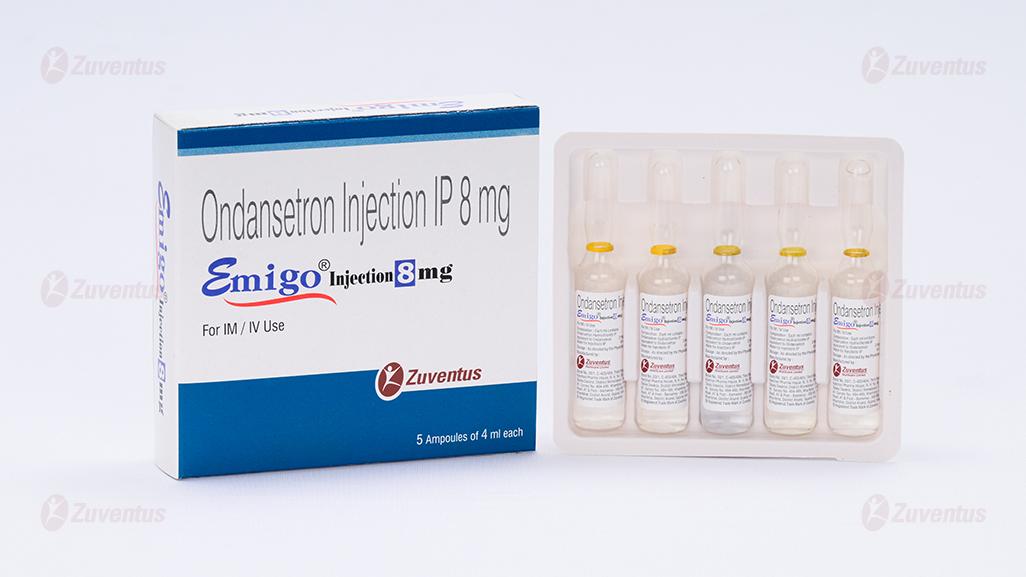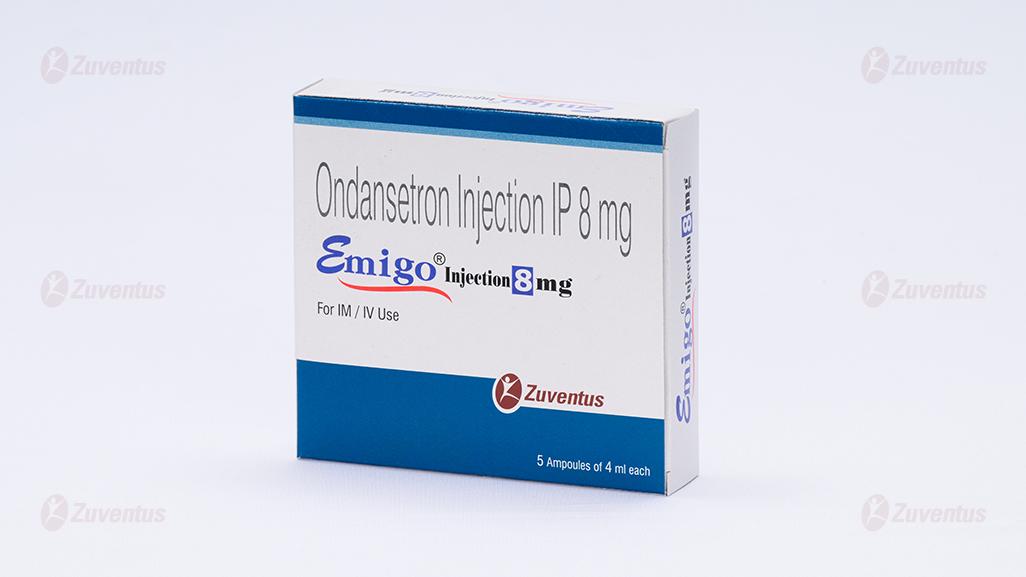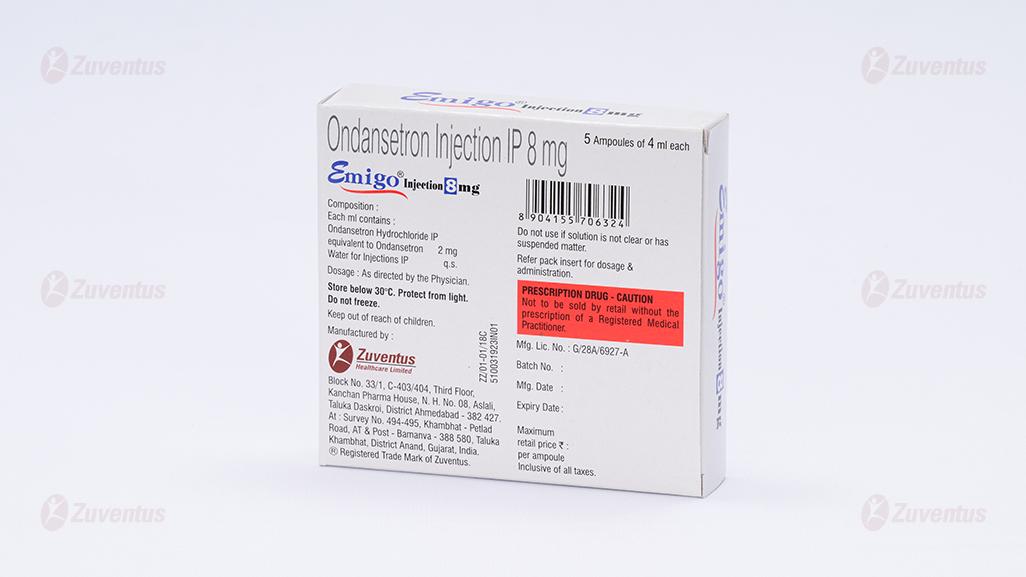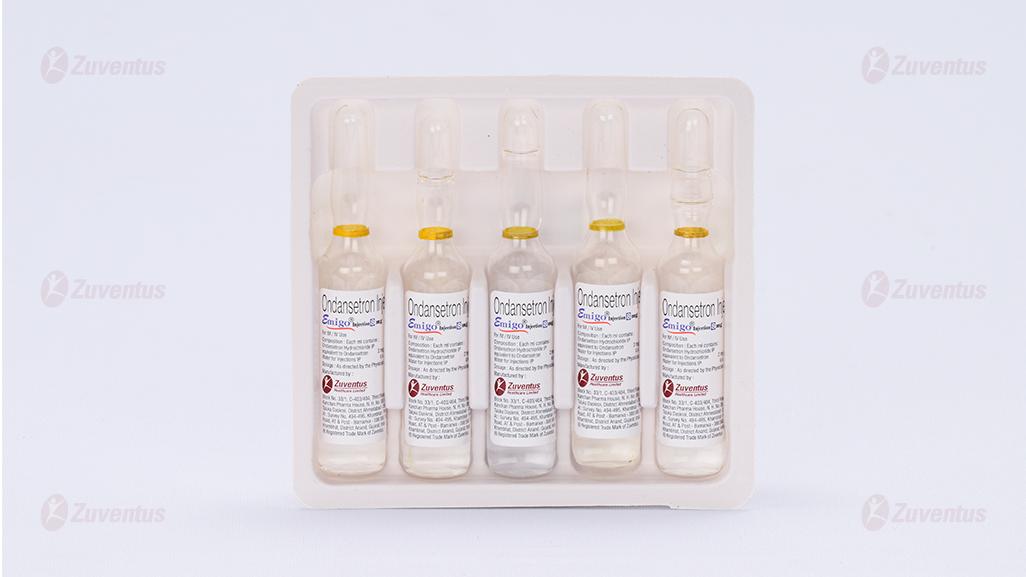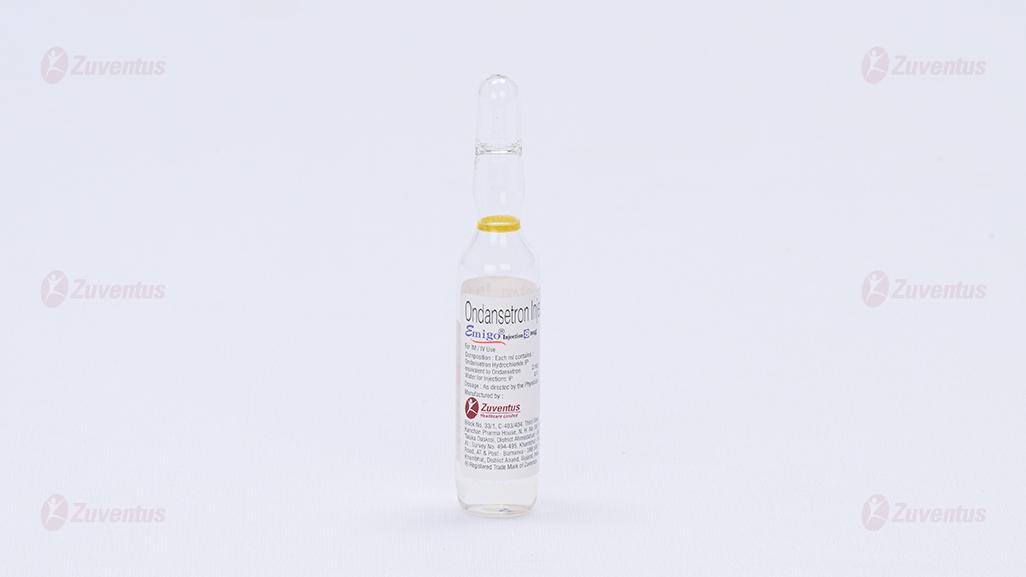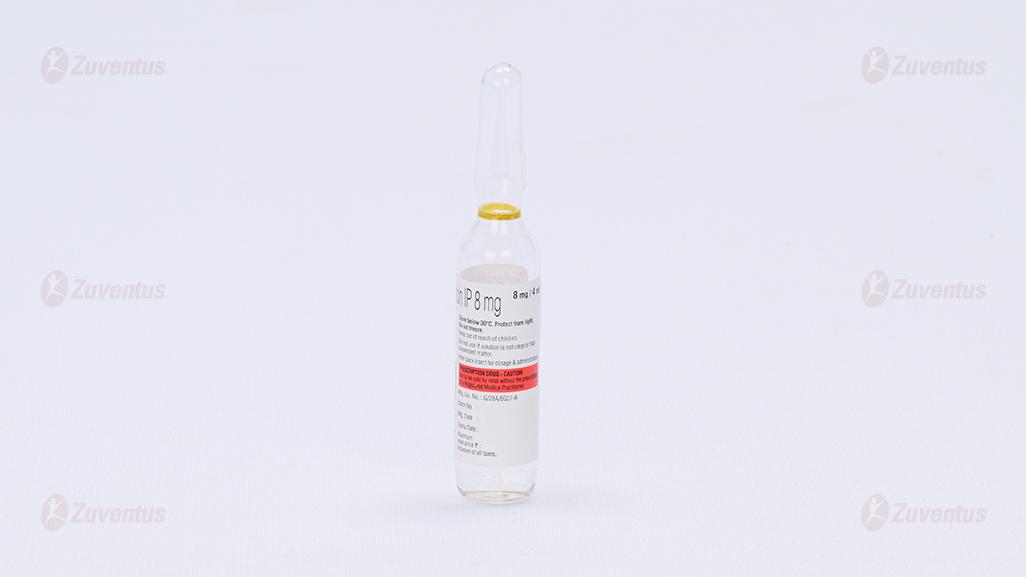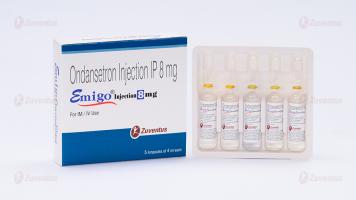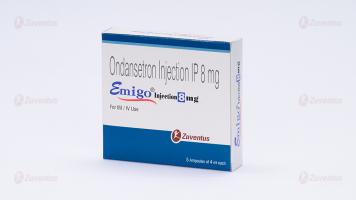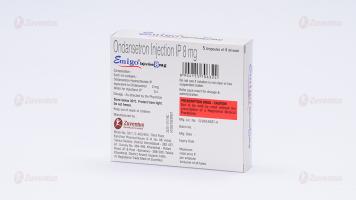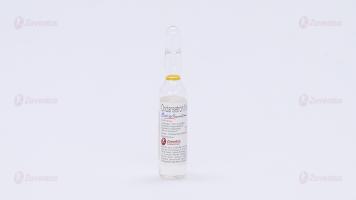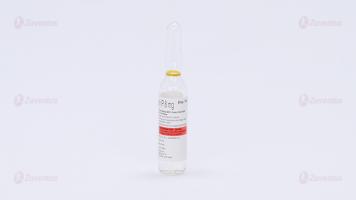Emigo 8 mg Injection
Therapy Area
Anti Emetic, Gastrointestinal
1.0 Generic name
Ondansetron Injection
2.0 Qualitative and quantitative composition
Emigo injection 4 mg/8 mg
Each ml contains:
Ondansetron Hydrochloride IP
equivalent to Ondansetron………………………………………… 2 mg
Water for Injections IP q.s.
3.0 Dosage form and strength
Injection 4 mg/8 mg
4.0 Clinical particulars
4.1 Therapeutic indication
In the treatment and management of nausea and vomiting induced by cytotoxic chemotherapy and radiotherapy.
4.2 Posology and method of administration
Chemotherapy and radiotherapy induced nausea and vomiting
Adults
The emetogenic potential of cancer treatment varies according to the doses and combinations of chemotherapy and radiotherapy regimens used. The dose range of ondansetron solution for injection or infusion is 8-32 mg a day and selected as shown below.
Emetogenic chemotherapy and radiotherapy
For patients receiving emetogenic chemotherapy or radiotherapy ondansetron can be given either by intravenous or other routes of administration, however this product is for intravenous use only.
The recommended intravenous dose of ondansetron is 8 mg administered as a slow injection (in not less than 30 seconds) or as an infusion over 15 minutes immediately before treatment, followed by treatment with dosage forms other than intravenous.
Treatment with dosage forms other than intravenous is recommended to protect against delayed or prolonged emesis after the first 24 hours.
Highly emetogenic chemotherapy
For patients receiving highly emetogenic chemotherapy, e.g. high-dose cisplatin, ondansetron can be given by intravenous or other routes of administration, however this product is for intravenous use only
Ondansetron has been shown to be equally effective in the following intravenous dose schedules over the first 24 hours of chemotherapy:
- A single dose of 8 mg by slow intravenous injection (in not less than 30 seconds) immediately before chemotherapy.
- A dose of 8 mg by slow intravenous injection (in not less than 30 seconds) or as a short
- time intravenous infusion over 15 minutes immediately before chemotherapy, followed by two further intravenous doses of 8 mg four hours apart, or by a constant infusion of 1 mg/hour for up to 24 hours.
- A maximum initial intravenous dose of 16 mg diluted in 50-100 ml of sodium chloride 9 mg/ml (0.9 % w/v) solution or other compatible infusion fluid and infused over not less than 15 minutes immediately before chemotherapy. The initial dose of Ondansetron may be followed by two additional 8 mg intravenous doses (in not less than 30 seconds) four hours apart. A single dose greater than 16 mg must not be given due to dose dependent increase of QT-prolongation risk.
The selection of dose regimen should be determined by the severity of the emetogenic challenge.
The efficacy of ondansetron in highly emetogenic chemotherapy may be enhanced by the addition of a single intravenous dose of dexamethasone sodium phosphate, 20 mg administered prior to chemotherapy.
To protect against delayed or prolonged emesis after the first 24 hours, ondansetron treatment with dosage forms other than intravenous should be continued after a course of treatment.
Paediatric Population:
CINV in children aged ≥ 6 months and adolescents
The dose for CINV can be calculated based on body surface area (BSA) or weight. Weightbased dosing results in higher total daily doses compared to BSA-based dosing.
Ondansetron injection should be diluted in 5% glucose or 0.9% sodium chloride or other compatible infusion fluid and infused intravenously over not less than 15 minutes. There are no data from controlled clinical trials on the use of Ondansetron in the prevention of delayed or prolonged CINV. There are no data from controlled clinical trials on the use of Ondansetron for radiotherapy-induced nausea and vomiting in children.
Dosing by BSA:
Ondansetron should be administered immediately before chemotherapy as a single intravenous dose of 5 mg/m2. The intravenous dose must not exceed 8 mg.
Oral dosing can commence twelve hours later and may be continued for up to 5 days (Table 1).
The total daily dose must not exceed adult dose of 32 mg.
Table 1: BSA-based dosing for Chemotherapy - Children aged ≥ 6 months and adolescents
| BSA | Day 1(a,b) | Days 2-6(b) |
| < 0.6 m2 | 5 mg/m2 i.v. plus 2 mg syrup after 12 hrs | 2 mg syrup every 12 hrs |
| ≥ 0.6 m2 | 5 mg/m2 i.v. plus 4 mg syrup or tablet after 12 hrs | 4 mg syrup or tablet every 12 hrs |
a The intravenous dose must not exceed 8mg
b The total daily dose must not exceed adult dose of 32 mg
Dosing by bodyweight:
Weight-based dosing results in higher total daily doses compared to BSA-based dosing.
Ondansetron should be administered immediately before chemotherapy as a single intravenous dose of 0.15 mg/kg. The intravenous dose must not exceed 8 mg. Two further intravenous doses may be given in 4-hourly intervals. The total daily dose must not exceed adult dose of 32 mg
Oral dosing can commence twelve hours later and may be continued for up to 5 days (Table 2)
Table 2: Weight-based dosing for Chemotherapy - Children aged ≥ 6 months and adolescents
| Weight | Day 1 (a,b) | Days 2-6(b) |
| ≤ 10 kg | Up to 3 doses of 0.15 mg/kg every 4 hrs | 2 mg syrup every 12 hrs |
| > 10 kg | Up to 3 doses of 0.15 mg/kg every 4 hrs | 4 mg syrup or tablet every 12 hrs |
a The intravenous dose must not exceed 8mg.
b The total daily dose must not exceed adult dose of 32 mg.
Elderly
In patients 65 to 74 years of age, the dose schedule for adults can be followed. All intravenous doses should be diluted in 50-100 ml of saline or other compatible infusion fluid and infused over 15 minutes.
In patients 75 years of age or older, the initial intravenous dose should not exceed 8 mg. All intravenous doses should be diluted in 50-100 ml of saline or other compatible infusion fluid and infused over 15 minutes. The initial dose of 8 mg may be followed by two further intravenous doses of 8 mg, infused over 15 minutes and given no less than four hours apart.
Post-operative nausea and vomiting (PONV)
Prevention of PONV
Adults: For the prevention of PONV ondansetron can be administered by intravenous injection or other dosage forms.
Ondansetron may be administered as a single dose of 4 mg given by slow intravenous injection at induction of anaesthesia.
Treatment of established PONV
For treatment of established PONV a single dose of 4 mg given by slow intravenous injection is recommended.
Paediatric population
PONV in children aged ≥ 1 month and adolescents
For prevention of PONV in paediatric patients having surgery performed under general anaesthesia, a single dose of ondansetron may be administered by slow intravenous injection (not less than 30 seconds) at a dose of 0.1 mg/kg up to a maximum of 4 mg either prior to, at or after induction of anaesthesia.
For the treatment of PONV after surgery in paediatric patients having surgery performed under general anaesthesia, a single dose of ondansetron may be administered by slow intravenous injection (not less than 30 seconds) at a dose of 0.1 mg/kg up to a maximum of 4 mg. There are no data on the use of ondansetron in the treatment of PONV in children below 2 years of age.
For treatment of established PONV in paediatric patients and adolescents, ondansetron may be administered by slow intravenous injection at a dose of 0.1 mg/kg up to a maximum of 4 mg.
Elderly
There is limited experience in the use of ondansetron in the prevention and treatment of PONV in the elderly, however ondansetron is well tolerated in patients over 65 years receiving chemotherapy.
Special Populations
Patients with renal impairment
No alteration of daily dosage or frequency of dosing, or route of administration is required.
Patients with hepatic impairment
Clearance of ondansetron is significantly reduced and serum half-life significantly prolonged in subjects with moderate or severe impairment of hepatic function. In such patients a total daily dose of 8 mg should not be exceeded.
Patients with poor sparteine/debrisoquine metabolism
The elimination half-life of ondansetron is not altered in subjects classified as poor metabolisers of sparteine and debrisoquine. Consequently, in such patients repeat dosing will give drug exposure levels no different from those of the general population. No alteration of daily dosage or frequency of dosing is required.
4.3 Contraindications
- Hypersensitivity to the active substance or to other selective 5-HT3 receptor antagonists (e.g. granisetron, dolasetron) or to any of the excipients listed in the formulation.
- Concomitant use with apomorphine.
4.4 Special warnings and precautions for use
Hypersensitivity reactions have been reported in patients who have exhibited hypersensitivity to other selective 5-HT3 receptor antagonists.
Respiratory events should be treated symptomatically and clinicians should pay particular attention to them as precursors of hypersensitivity reactions.
Ondansetron prolongs the QT interval in a dose-dependent manner. In addition, postmarketing cases of Torsade de Pointes have been reported in patients using ondansetron. Avoid ondansetron in patients with congenital long QT syndrome. Ondansetron should be administered with caution to patients who have or may develop prolongation of QTc. These conditions include patients with electrolyte abnormalities, congestive heart failure,bradyarrhythmias or patients taking other medicinal products that lead to QT prolongation or electrolyte abnormalities.
Cases of myocardial ischemia have been reported in patients treated with ondansetron. In some patients, especially in the case of intravenous administration, symptoms appeared immediately after administration of ondansetron. Patients should be alerted to the signs and symptoms of myocardial ischaemia.
Hypokalaemia and hypomagnesaemia should be corrected prior to ondansetron administration.
There have been post-marketing reports describing patients with serotonin syndrome (including altered mental status, autonomic instability and neuromuscular abnormalities) following the concomitant use of ondansetron and other serotonergic drugs (including selective serotonin reuptake inhibitors (SSRI) and serotonin noradrenaline reuptake inhibitors (SNRIs)). If concomitant treatment with ondansetron and other serotonergic drugs is clinically warranted, appropriate observation of the patient is advised.
As ondansetron is known to increase large bowel transit time, patients with signs of subacute intestinal obstruction should be monitored following administration.
In patients with adenotonsillar surgery prevention of nausea and vomiting with ondansetron may mask occult bleeding. Therefore, such patients should be followed carefully after ondansetron.
Paediatric Population:
Paediatric patients receiving ondansetron with hepatotoxic chemotherapeutic agents should be monitored closely for impaired hepatic function.
4.5 Drugs interactions
Effects of ondansetron on other medicinal products
There is no evidence that ondansetron either induces or inhibits the metabolism of other drugs commonly co administered with it. Specific studies have shown that ondansetron does not interact with alcohol, temazepam, furosemide, alfentanil, morphine, lignocaine, propofol and thiopental.
Effects of other medicinal products on ondansetron
Ondansetron is metabolised by multiple hepatic cytochrome P-450 enzymes: CYP3A4, CYP2D6 and CYP1A2. Due to the multiplicity of metabolic enzymes capable of metabolising ondansetron, enzyme inhibition or reduced activity of one enzyme (e. g. CYP2D6 genetic deficiency) is normally compensated by other enzymes and should result in little or no significant change in overall ondansetron clearance or dose requirement.
Caution should be exercised when ondansetron is co administered with drugs that prolong the QT interval and/or cause electrolyte abnormalities.
Use of ondansetron with QT prolonging drugs may result in additional QT prolongation. Concomitant use of ondansetron with cardiotoxic drugs (e.g. anthracyclines such as doxorubicin, daunorubicin or trastuzimab), antibiotics (such as erythromycin or ketoconazole), antiarrhythmics (such as amiodarone) and beta blockers (such as atenolol or timolol) may increase the risk of arrhythmias.
There have been post-marketing reports describing patients with serotonin syndrome (including altered mental status, autonomic instability and neuromuscular abnormalities) following the concomitant use of ondansetron and other serotonergic drugs (including SSRIs and SNRIs).
Apomorphine: Based on reports of profound hypotension and loss of consciousness when ondansetron was administered with apomorphine hydrochloride, concomitant use with apomorphine is contraindicated.
Phenytoin, carbamazepine and rifampicin: In patients treated with potent inducers of CYP3A4 (i.e. phenytoin, carbamazepine and rifampicin), the oral clearance of ondansetron was increased and ondansetron blood concentrations were decreased.
Tramadol: Data from small studies indicate that ondansetron may reduce the analgesic effect of tramadol.
4.6 Use in special populations
Women of childbearing potential
Women of childbearing potential should consider the use of contraception.
Pregnancy
Based on human experience from epidemiological studies, ondansetron is suspected to cause orofacial malformations when administered during the first trimester of pregnancy.
In one cohort study including 1.8 million pregnancies, first trimester ondansetron use was associated with an increased risk of oral clefts (3 additional cases per 10 000 women treated; adjusted relative risk, 1.24, (95% CI 1.03-1.48)).
The available epidemiological studies on cardiac malformations show conflicting results.
Animal studies do not indicate direct or indirect harmful effects with respect to reproductive toxicity. However, Ondansetron should not be used during the first trimester of pregnancy.
Lactation
Tests have shown that ondansetron passes into the milk of lactating animals. It is therefore recommended that mothers receiving ondansetron should not breast-feed their babies.
4.7 Effects on ability to drive and use machines
Ondansetron has no or negligible influence on the ability to drive and use machines.
4.8 Undesirable effects
Immune system disorders
Rare:
Immediate hypersensitivity reactions, sometimes severe including anaphylaxis. Anaphylaxis may be fatal. Hypersensitivity reactions were also observed in patients, who were sensitive towards other selective 5-HT3 receptor antagonists.
Nervous system disorders
Very common: Headache.
Uncommon:
There have been reports suggestive of involuntary movement disorders such as extrapyramidal reactions, e.g. oculogyric crisis/dystonic reactions and dyskinesia without definitive evidence of persistent clinical sequelae and seizures (e.g. epileptic spasms) have been observed although no known pharmacological mechanism can account for ondansetron causing these effects.
Rare:
Dizziness during rapid intravenous administration.
Very rare:
Depression.
Eye disorders
Rare:
Transient visual disturbances (e.g. blurred vision) during rapid intravenous administration.
Very rare:
In individual cases transitory blindness was reported in patients receiving chemotherapeutic agents including cisplatin. Most reported cases were resolved within 20 minutes. Some cases of transient blindness were reported as cortical in origin.
Cardiac disorders
Uncommon:
Chest pain with or without ST segment depression, cardiac arrhythmias and bradycardia. Chest pain and cardiac arrhythmias may be fatal in individual cases.
Rare:
Transitory changes in the electrocardiogram, QTc prolongation (including Torsades de Pointes)
Unknown:
Vascular disorders
Common: Sensations of flushing or warmth.
Uncommon: Hypotension.
Respiratory, thoracic and mediastinal disorders
Uncommon: Hiccups.
Gastrointestinal disorders
Common: Ondansetron is known to increase the large bowel transit time and may cause constipation in some patients.
Hepatobiliary disorders
Uncommon: Asymptomatic increases in liver function tests were observed. These reactions were frequently observed in patients under chemotherapy with cisplatin.
Skin and subcutaneous tissue disorders
Uncommon: Hypersensitivity reactions around the injection site (e.g. rash, urticaria, itching) may occur, sometimes extending along the drug administration vein.
General disorders and administration site conditions
Common: Local reactions at the IV injection site.
Paediatric population
The adverse event profile in children and adolescents was comparable to that seen in adults.
Reporting of suspected adverse reactions
Reporting suspected adverse reactions after authorisation of the medicinal product is important. It allows continued monitoring of the benefit/risk balance of the medicinal product. Healthcare professionals are asked to report any suspected adverse reactions via email to: medico@zuventus.com
Website: https://www.zuventus.com/drug-safety-reporting
By reporting side effects, you can help provide more information on the safety of this medicine.
4.9 Overdose
Little is known at present about overdosage with ondansetron, however, a limited number of patients received overdoses. In the majority of cases, symptoms were similar to those already reported in patients receiving recommended doses. Manifestations that have been reported include visual disturbances, severe constipation, hypotension and a vasovagal episode with transient second degree AV block. In all instances, the events resolved completely. Ondansetron prolongs the QT interval in a dose-dependent fashion. ECG monitoring is recommended in cases of overdose.
There is no specific antidote for ondansetron, therefore in all cases of suspected overdose, symptomatic and supportive therapy should be given as appropriate. The use of ipecacuanha to treat overdose with ondansetron is not recommended, as patients are unlikely to respond due to the anti-emetic action of ondansetron itself.
Paediatric population
Paediatric cases consistent with serotonin syndrome have been reported after inadvertent oral overdoses of ondansetron (exceeded estimated ingestion of 4 mg/kg) in infants and children aged 12 months to 2 years.
5.0 Pharmacological properties
5.1 Mechanism of action
Ondansetron is a potent, highly selective 5HT3 receptor-antagonist.
Its precise mode of action in the control of nausea and vomiting is not known. Chemotherapeutic agents and radiotherapy may cause release of 5HT in the small intestine initiating a vomiting reflex by activating vagal afferents via 5HT3 receptors. Ondansetron blocks the initiation of this reflex. Activation of vagal afferents may also cause a release of 5HT in the area postrema, located on the floor of the fourth ventricle, and this may also promote emesis through a central mechanism. Thus, the effect of ondansetron in the management of the nausea and vomiting induced by cytotoxic chemotherapy and radiotherapy is probably due to antagonism of 5HT3 receptors on neurons located both in the peripheral and central nervous system. The mechanisms of action in post-operative nausea and vomiting are not known but there may be common pathways with cytotoxic induced nausea and vomiting.
5.2 Pharmacodynamic properties
The effect of ondansetron on the QTc interval was evaluated in a double blind, randomised, placebo and positive (moxifloxacin) controlled, crossover study in 58 healthy adult men and women. Ondansetron doses included 8 mg and 32 mg infused intravenously over 15 minutes. At the highest tested dose of 32 mg, the maximum mean (upper limit of 90% CI) difference in QTcF from placebo after baseline-correction was 19.6 (21.5) msec. At the lower tested dose of 8 mg, the maximum mean (upper limit of 90% CI) difference in QTcF from placebo after baseline-correction was 5.8 (7.8) msec. In this study, there were no QTcF measurements greater than 480 msec and no QTcF prolongation was greater than 60 msec. No significant changes were seen in the measured electrocardiographic PR or QRS intervals.
5.3 Pharmacokinetic properties
Absorption
Following oral administration, ondansetron is passively and completely absorbed from the gastrointestinal tract and undergoes first pass metabolism (Bioavailability is about 60%.). Peak plasma concentrations of about 30 ng/ml are attained approximately 1.5 hours after an 8 mg dose. For doses above 8 mg the increase in ondansetron systemic exposure with dose is greater than proportional; this may reflect some reduction in first pass metabolism at higher oral doses. Bioavailability, following oral administration, is slightly enhanced by the presence of food but unaffected by antacids.
A 4 mg intravenous infusion of ondansetron given over 5 minutes results in peak plasma concentrations of about 65 ng/ml. Following intramuscular administration of ondansetron, peak plasma concentrations of about 25 ng/ml are attained within 10 minutes of injection.
Distribution
The disposition of ondansetron following oral, intramuscular (IM) and intravenous (IV) dosing is similar with a steady state volume of distribution of about 140 L. Equivalent systemic exposure is achieved after IM and IV administration of ondansetron.
Ondansetron is not highly protein bound (70-76%).
Metabolism
Ondansetron is cleared from the systemic circulation predominantly by hepatic metabolism through multiple enzymatic pathways. The absence of the enzyme CYP2D6 (the debrisoquine polymorphism) has no effect on ondansetron's pharmacokinetics.
Excretion
Less than 5% of the absorbed dose is excreted unchanged in the urine. Terminal half-life is about 3 hours.
6.0 Nonclinical Properties
6.1 Animal Toxicology or Pharmacology
Preclinical data revealed no special hazard for humans based on conventional studies of safety, pharmacology, repeated dose toxicity, genotoxicity, carcinogenic potential and toxicity to reproduction.
Ondansetron and its metabolites accumulate in the milk of rats, milk/plasma-ratio was 5.2:1. A study in cloned human cardiac ion channels has shown ondansetron has the potential to affect cardiac repolarisation via blockade of HERG potassium channels. The clinical relevance of this finding is uncertain.
7.0 Description
The active ingredient of Ondansetron Injection, is ondansetron hydrochloride, a selective blocking agent of the serotonin 5-HT3 receptor type. Its chemical name is (±) 1, 2, 3, 9-tetrahydro-9-methyl-3-[(2-methyl-1H-imidazol-1-yl)methyl]-4H-carbazol-4- one, monohydrochloride, dihydrate.
8.0 Pharmaceutical particulars
Rare : Immediate hypersensitivity reactions, sometimes severe including anaphylaxis. Anaphylaxis may be fatal.
Hypersensitivity reactions were also observed in patients, who were sensitive towards other selective 5- HT receptor antagonists.
Nervous system disorders
Very common : Headache
Uncommon : There have been reports suggestive of involuntary movement disorders such as extrapyramidal reactions, e.g. oculogyric crisis/dystonic reactions and dyskinesia without definitive evidence of persistent clinical sequelae and seizures (e.g. epileptic spasms) have been observed although no known pharmacological mechanism can account for ondansetron causing these effects.
Rare : Dizziness during rapid intravenous administration.
Very rare : Depression.
Eye disorders
Rare : Transient visual disturbances (e.g. blurred vision) during rapid intravenous administration.
Very rare : In individual cases transitory blindness was reported in patients receiving chemotherapeutic agents including cisplatin. Most reported cases were resolved within 20 minutes. Some cases of transient blindness were reported as cortical in origin.
8.3 Storage and handing instructions
Store below 30°C. Protect from light.
Keep out of reach of children.
Do not freeze. Do not use if solution is not clear or has suspended matter.
9.0 Patient counselling information
QT Prolongation
Patients should be informed that Ondansetron Injection may cause serious cardiac arrhythmias such as QT prolongation. Patients should be instructed to tell their healthcare provider right away if they perceive a change in their heart rate, if they feel lightheaded, or if they have a syncopal episode.
Patients should be informed that the chances of developing severe cardiac arrhythmias such as QT prolongation and Torsade de Pointes are higher in the following people:
- Patients with a personal or family history of abnormal heart rhythms, such as congenital long QT syndrome
- Patients who take medications, such as diuretics, which may cause electrolyte abnormalities.
- Patients with hypokalemia or hypomagnesemia.
Ondansetron Injection should be avoided in these patients, since they may be more at risk for cardiac arrhythmias such as QT prolongation and Torsade de Pointes.
Hypersensitivity Reactions
Inform patients that Ondansetron Injection may cause hypersensitivity reactions, some as severe as anaphylaxis and bronchospasm. The patient should report any signs and symptoms of hypersensitivity reactions, including fever, chills, rash, or breathing problems.
Masking of Progressive Ileus and Gastric Distension
Inform patients following abdominal surgery or those with chemotherapy-induced nausea and vomiting that Ondansetron Injection may mask signs and symptoms of bowel obstruction. Instruct patients to immediately report any signs or symptoms consistent with a potential bowel obstruction to their healthcare provider.
Drug Interactions
- Instruct the patient to report the use of all medications, especially apomorphine, to their healthcare provider. Concomitant use of apomorphine and Ondansetron Injection may cause a significant drop in blood pressure and loss of consciousness.
- Advise patients of the possibility of serotonin syndrome with concomitant use of Ondansetron Injection and another serotonergic agent such as medications to treat depression and migraines. Advise patients to seek immediate medical attention if the following symptoms occur: changes in mental status, autonomic instability, neuromuscular symptoms with or without gastrointestinal symptoms.
12.0 Date of revision
18.09.2022
About Leaflet
Read all of this leaflet carefully before you start taking this medicine because it contains important information for you.
- Keep this leaflet. You may need to read it again.
- If you have any further questions, ask your doctor or pharmacist or nurse.
- This medicine has been prescribed for you only. Do not pass it on to others. It may harm them, even if their signs of illness are the same as yours.
- If you get any side effects, talk to your doctor or pharmacist or nurse. This includes any possible side effects not listed in this leaflet.
What is in this leaflet:
- What EMIGO® is and what it is used for
- What you need to know before you take EMIGO®
- How to take EMIGO®
- Possible side effects
- How to store EMIGO®
- Contents of the pack and other information
1. What EMIGO® is and what it is used for
The active ingredient in EMIGO® injection is ondansetron. It belongs to a group of medicines called anti-emetics.
It is used against feeling sick or being sick. Some medical treatment with medicines for treatment of cancer (chemotherapy) or radiotherapy can make you feel sick or be sick. Also after surgical treatment you can feel sick or be sick. Ondansetron 2 mg/ ml may help to reduce these effects.
Ask your doctor, nurse, or pharmacist if you would like any further explanation about these uses.
2. What you need to know before you take EMIGO®
Do not take EMIGO®, if
If you are allergic (hypersensitive) to ondansetron, any of the other ingredients of Ondansetron 2 mg/ml or to medicinal products from the same class (e.g. granisetron or dolasetron).
If you are taking apomorphine (a medicine used to treat Parkinson’s disease).
If you are not sure, talk to your doctor, nurse, or pharmacist before taking EMIGO® injection.
Warnings and precautions
Talk to your doctor, pharmacist or nurse before taking EMIGO® injection if:
- you are hypersensitive to other medicines against feeling sick or being sick.
- you have a blockage in your gut or suffer from severe constipation. Ondansetron can enhance the blockage or constipation.
- you have cardiac problems (e.g. congestive heart failure which causes shortness of breath and swollen ankles).
- you have an uneven heart beat (arrhythmias).
- you are having your tonsils out.
- your liver is not working as well as it should.
- you have problems with the levels of salts in your blood, such as potassium, sodium and magnesium.
If you are not sure if any of the above apply to you, talk to your doctor, nurse, or pharmacist before taking EMIGO® injection.
Other medicines and EMIGO®
Tell your doctor or pharmacist if you are taking, have recently taken or might take any other medicines. This includes medicines obtained without a prescription and herbal medicines.
Tell your doctor or pharmacist if you are taking any of the following medicines:
- Phenytoin or carbamazepine used to treat epilepsy
- Rifampicin used to treat infections such as tuberculosis (TB)
- Tramadol, a pain killer
- Antibiotics such as erythromycin or ketoconazole,
- Anti-arrhythmic medicines used to treat an uneven heartbeat,
- Beta-blocker used to treat certain heart or eye problems, anxiety or prevent migraines
- Medicines that affect the heart (such as haloperidol or methadone),
- SSRIs (selective serotonin reuptake inhibitors) used to treat depression and/or anxiety including fluoxetine, paroxetine, sertraline, fluvoxamine, citalopram, escitalopram,
- SNRIs (serotonin noradrenaline reuptake inhibitors) used to treat depression and/or anxiety including venlafaxine, duloxetine,
- Anthracylines (cancer medicine)
Ondansetron changes the effect of some drugs and vice versa. This includes:
- Apomorphine (a medicine used to treat Parkinson’s disease): a significant drop in blood pressure and loss of consciousness has been reported with concomitant use of ondansetron and apomorphine.
- Tramadol (a painkiller): ondansetron may reduce the analgesic effect of tramadol.
- Phenytoin, carbamazepine (anti-epileptics) and rifampicin (an antibiotic): the blood concentrations of ondansetron are decreased.
Pregnancy and breast-feeding
Only use Ondansetron 2 mg/ml during the first trimester of pregnancy after discussion with your doctor of the potential benefits and risks to you and your unborn baby of the different treatment options. This is because Ondansetron 2 mg/ml can slightly increase the risk of a baby being born with cleft lip and/or cleft palate (openings or splits in the upper lip and/or the roof of the mouth). If you are already pregnant, think you might be pregnant or are planning to have a baby, ask your doctor or pharmacist for advice before taking Ondansetron 2 mg/ml. If you are a woman of childbearing potential, you may be advised to use effective contraception.
Ondansetron passes into mother’s milk. Therefore, mothers receiving ondansetron should NOT breast-feed.
Driving and using machines
Ondansetron has no or negligible effect on the ability to drive or use machines.
3. How to use EMIGO®
Method of administration
Ondansetron 2 mg/ml is given as intravenous injection (into a vein) or, after dilution, as intravenous infusion (for a longer time). It will usually be given by a doctor or a nurse.
Dosage
Your doctor will decide on the correct dose of ondansetron therapy for you. The dose varies depending on your medicinal treatment (chemotherapy or surgery), on your liver function and on whether it is given by injection or infusion. In case of chemotherapy or radiotherapy the usual dose in adults is 8 - 32 mg ondansetron a day. For treatment of post-operative nausea and vomiting a single dose of 4 mg ondansetron is usually given.
Use in children and adolescents
Children aged over 6 months and adolescents The doctor will decide the dose. In cases of chemotherapy or radiotherapy, the usual dose in children and adolescents is 4 mg. Children aged over 1 month and adolescents The doctor will decide the dose. For treatment of post-operative nausea and vomiting a maximum dose of 4 mg is given into a vein.
Dosage adjustment
Patients with hepatic impairment: In patients having hepatic problems, the dose has to be adjusted to a maximum daily dose of 8 mg ondansetron.
Elderly:
There is limited experience in the use of ondansetron in the prevention and treatment of post-operative nausea and vomiting (PONV) in the elderly, however ondansetron is well tolerated in patients over 65 years receiving chemotherapy. Patients with renal impairment or poor sparteine/debrisoquine metabolism: No alteration of daily dosage or frequency of dosing or route of administration is required.
Duration of treatment
Your doctor will decide on the duration of ondansetron therapy for you. After intravenous administration of Ondansetron 2 mg/ml the therapy may be continued with other dosage forms.
If you use more Ondansetron 2 mg/ml than you should
Little is known at present about overdosage with ondansetron. In a few patients, the following effects were observed after overdose: visual disturbances, severe constipation, low blood pressure and unconsciousness. In all cases, the symptoms disappeared completely. There is no specific antidote to ondansetron; for that reason, if overdose is suspected, only the symptoms should be treated.
Tell your doctor if any of these symptoms occur. Your doctor or nurse will give you or your child Ondansetron 2 mg/ml so it is unlikely that you or your child will receive too much.
If you think you or your child have been given too much or have missed a dose, tell your doctor or nurse.
If you have any further questions on the use of this product, ask your doctor or pharmacist.
4. Possible side effects
Like all medicines, EMIGO® Injection can cause side effects, although not everybody gets them.
Uncommon (may affect up to 1 in 100 people):
- Chest pain, cardiac arrhythmias (changes in the way your heart beats) and bradycardia (slow heart rate). Chest pain and cardiac arrhythmias may be fatal in individual cases.
Rare (may affect up to 1 in 1,000 people):
- Immediate allergic (hypersensitivity) reactions (reaction in which the body reacts with an exaggerated immune response to a foreign agent), including life-threatening allergic reaction. These reactions may be: swelling of the hands, feet, ankles, face, lips, mouth or throat which may cause difficulty in swallowing or breathing. Additionally, rash or itching and hives.
Altered hypersensitivity reactions were also observed in patients, who were sensitive to medicinal products from the same class. Inform your doctor immediately if you experience any symptoms suggestive of an allergic reaction.
Very Common (may affect more than 1 in 10 people):
- Headache.
Common (may affect up to 1 in 10 people):
- Sensations of flushing or warmth.
- Ondansetron is known to increase the large bowel transit time and may cause constipation in some patients.
- Local reactions at the IV injection site.
Uncommon (may affect up to 1 in 100 people):
- Involuntary movement disorders, e.g. spasmodic movement of eyeballs, abnormal muscle contractions that may cause twisting or jerking movements of the body, seizures (e.g. epileptic spasms).
- Hypotension (low blood pressure).
- Hiccups.
- Asymptomatic increases of liver function. These reactions were particularly observed in patients under chemotherapy with cisplatin.
- Hypersensitivity reactions around the injection site (e.g. rash, urticaria, itching) may occur, sometimes extending along the drug administration vein.
Rare (may affect up to 1 in 1,000 people):
- Transitory changes in the electrocardiogram (ECG) predominantly after intravenous application of ondansetron. QTc prolongation (including Torsades de Pointes)
- Dizziness during rapid intravenous administration.
- Transient visual disturbances (e.g. blurred vision) during rapid intravenous administration.
Very rare (may affect up to 1 in 10,000 people):
- Depression.
- In individual cases transitory blindness was reported in patients receiving chemotherapeutic agents including cisplatin. Most reported cases resolved within 20 minutes. Some cases of transient blindness were reported as cortical in origin.
If any of the side effects becomes serious, or if you notice any side effects not listed in this leaflet, please tell your doctor.
Reporting of side effects
If you get any side effects, talk to your doctor, pharmacist or nurse. This includes any possible side effects not listed in this leaflet. You can also report side effects directly: Website: www.zuventus.com and click the tab “Drug Safety Reporting” located on the top right end of the home page. By reporting side effects, you can help provide more information on the safety of this medicine.
You can also report the side effect with the help of your treating physician.
5. How to store EMIGO®
Keep this medicine out of the sight and reach of children.
Do not use this medicine after the expiry date which is stated on the ampoule label and carton. The expiry date refers to the last day of that month.
Keep the ampoules in the outer carton, in order to protect from light.
Do not throw away any medicines via wastewater or household waste. Ask your pharmacist how to throw away medicines you no longer use. These measures will help protect the environment.
6. Contents of the pack and other information
EMIGO® 4 mg
Each ml contains:
Ondansetron Hydrochloride IP
equivalent to Ondansetron 2mg
EMIGO® 8 mg
Each ml contains:
Ondansetron Hydrochloride IP
equivalent to Ondansetron 2mg

